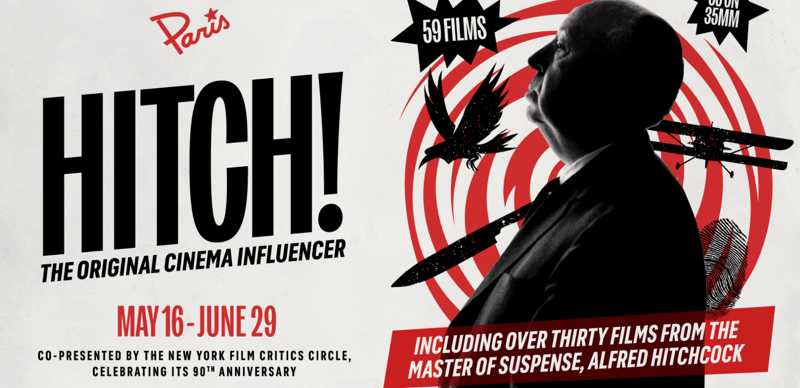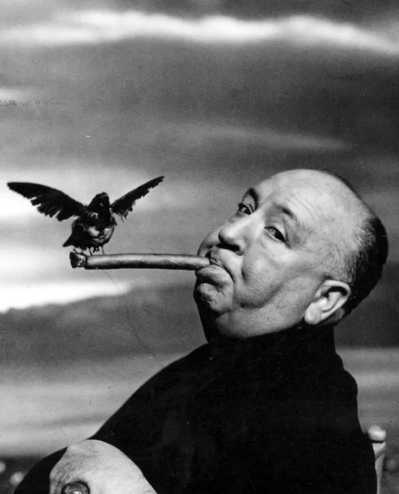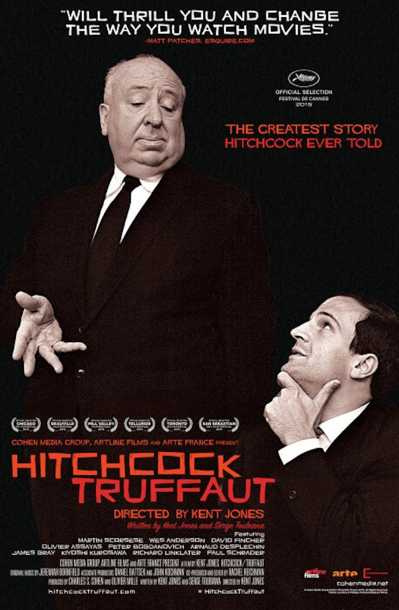맨해튼 파리 시어터 알프레드 히치콕 영화제 'Hitch!' (5/16-6/29)
HITCH! The Oroginal Cinema Influencer
May 16 through June 29
@Paris Theater

오늘날 공포영화는 모두 '서스펜스의 거장' 알프레드 히치콕(Alfred HItchcock, 1899-1980)에게 빚을 지고 있다.
맨해튼 플라자호텔 옆의 파리 시어터(Paris Theater, 4 West 58th Street)에서 5월 16일부터 6월 29일까지 6주간 알프레드 히치콕 영화제 '히치! 오리지널 시네마 인플루언서 (HITCH! The Oroginal Cinema Influencer)'를 연다. 이 영화제에선 히치콕의 연출작 '현기증(Vertigo)' '이창(Rear WIndow)' 36편을 비롯, 그의 유산을 기리는 작품 등 총 60편이 상영된다.
'히치! 오리지널 시네마 인플루언서'는 히치코크의 기법과 영향력이 영국에서 제작된 무성 영화 '블랙메일'과 스파이 스릴러 '레이디 바니쉬'를 시작으로 시대순으로 전개되는 과정을 살펴본다. '레이디 바니쉬'는 히치코크가 대중문화에 뿌리내릴 수 있는 초기 지표로 평가된다. 이와 함께 캐럴 리드(제 3의 사나이)의 '뮌헨행 야간열차'도 볼수 있다.
또한, 히치콕이 독일 영화계에서 활동하는 동안 연구했던 F.W. 무르나우와 프리츠 랑을 비롯한 독일 표현주의 거장들의 영화도 상영된다. 자막이나 과도한 대사에 의존하지 않는 그들의 독창적인 시각적 스토리텔링 방식은 히치코크의 영화 연출에 중요한 지침이 되었다.
히치콕은 할리우드로 가서 스타 파워와 거장 감독 스타일을 결합시키며 1940년 '레베카'로 생애 처음이자 유일한 아카데미 작품상을 수상했다. 제2차 세계대전은 그의 영화에 영향을 끼쳤다. '외신 특파원', '사보추어', '구명보트' 등 스파이 스릴러와 단편 영화 '즐거운 여행'과 '말가슈 모험'에서 여실히 드러난다.
1950년대는 히치콕의 전성기였다. 그레이스 켈리, 제임스 스튜어트, 캐리 그랜트, 잉그리드 버그만, 몽고메리 클리프, 마를레네 디트리히 등 국제적인 스타들이 히치콕의 메거폰 앞에 섰다. 스릴러 '이창'부터 심리학적 미궁을 파고드는 '현기증'까지, 히치콕은 역사상 가장 위대한 영화 중 하나로 손꼽히는 명작을 연출했다. 이어 전설적인 '사이코'로 오늘날 공포 장르의 이정표를 세웠으며, '새'로 종말론적 파멸을 예고하는 비전을 제시했다.
히치콕은 경력의 막바지에 이르러서 유쾌하면서도 악랄한 '프렌지'와 유작인 다크 코미디 '패밀리 플롯'을 연출했다. 이 시기에는 히치콕과의 대화를 책으로 출판했던 프랑소와 트뤼포의 스릴러 '검은 신부'에서 멜 브룩스의 패러디 '하이 앤자이어티'까지, 서스펜스의 거장 히치콕에게 깊이 빚진 작품들을 만들어내는 새로운 세대의 영화 감독들이 등장했다. 20여 년 후, 로버트 저메키스(백 투더 퓨쳐)는 해리슨 포드와 미셸 파이퍼 주연의 'What Lies Beneath'로 자신만의 히치콕식 스릴러를 선보였다.
이외에도 영화비평가 켄트 존스의 다큐멘터리 '히치콕/트뤼포'와 마크 커진스의 '내 이름은 알프레드 히치콕'도 볼 수 있다. 시리즈의 35편은 35밀리 프린트로 상영된다.

HITCH! The Oroginal Cinema Influencer
The Paris Theater is proud to present HITCH! The Original Cinema Influencer, a six-week series running from May 16 through June 29, featuring nearly 60 films—36 directed by the Master of Suspense himself, along with many that trace the stylistic influences behind Hitchcock’s filmmaking, and more than a dozen others that stand as homages to his legacy.
As horror and thrillers continue to dominate the box office, spawning ever more lucrative franchises, it’s worth tracing the roots of this enduring appeal. Alfred Hitchcock, the Master of Suspense, didn’t single-handedly invent the horror genre, but the influences he drew from and the techniques he pioneered during his career still cast a long shadow over modern audiences’ ever-growing thirst for thrills and chills.
HITCH! The Original Cinema Influencer will chart the progression of Hitchcock’s technique and influence chronologically, beginning with his early films made in England such as the silent film Blackmail, as well as spy thriller The Lady Vanishes. The latter was an early indicator of Hitchcock’s ability to take root in popular culture, as the performances of Basil Radford and Naunton Wayne as Charters and Caldicott proved so popular, the actors would go on to reprise their roles in five more films – including Carol Reed’s Night Train to Munich, which will play in special double feature shows with The Lady Vanishes. We’ll also showcase films by some of the German expressionist masters, including F.W. Murnau and Fritz Lang, whose work Hitchcock studied during his time in the German film industry. Their inventive approach to visual storytelling—relying less on title cards or excessive dialogue—became a guiding principle in Hitchcock’s own filmmaking.
Hollywood would soon come calling for Hitchcock, pairing incredible star power with his increasingly virtuosic directorial style. This era would see him win his only Best Picture Oscar - for 1940’s Rebecca - and would be heavily influenced by World War II, seen clearly in spy thrillers like Foreign Correspondent, Saboteur, and Lifeboat, as well as two rarely-screened short films (Bon Voyage and Aventure Malgache) made by Hitchcock to aid in the war effort, but shelved by government officials for being “inflammatory”.
The 1950s saw Hitchcock in peak form, with internationally beloved movie stars like Grace Kelly, James Stewart, Cary Grant, Ingrid Bergman, Montgomery Clift, and Marlene Dietrich all lining up to headline some of the director’s most universally praised classics – from the pulse-pounding thriller Rear Window, to the psychological labyrinth of Vertigo, which frequently polls as one the greatest films ever made. But despite acclaim and success, Hitchcock’s appetite for grit, experimentation and boundary-pushing never waned, well into the 1960s where he completely upended audience expectations and helped launched horror as the popular genre it is today with the legendary Psycho, and delivered a vision of apocalyptic doom with The Birds.
As his career drew to a close, Hitchcock continued to deliver surprises— through the entertainingly vicious Frenzy and the dark comedy of his final film, Family Plot. This period also saw a new generation of filmmakers producing work clearly indebted to the Master of Suspense—from the overt thrills of Truffaut’s The Bride Wore Black to the affectionate parody of Mel Brooks’ High Anxiety. Over two decades later, Robert Zemeckis offered his own Hitchcockian thriller with What Lies Beneath—a tradition that continues to this day, as many of today’s horror auteurs trace their cinematic lineage back to Hitchcock.
Thirty-five films in this series will have showings in 35mm, including Hitchcock classics like Rear Window, Vertigo, North by Northwest, and The Lady Vanishes, as well as enduring masterpieces like Francois Truffaut’s The Bride Wore Black, Fritz Lang’s M, and Henri-Georges Clouzot’s Diabolique, screening on an imported 35mm print courtesy of Institut Français. We’ll also have special treats like two episodes of Alfred Hitchcock Presents, featuring memorable small screen roles for stars like Steve McQueen and Peter Lorre and the directing prowess of multi-hypenate Ida Lupino. And those curious to learn more about the filmmaker’s history can take in two featured documentaries: Kent Jones’ Hitchcock/Truffaut, and My Name is Alfred Hitchcock by Mark Cousins.

Featuring 35mm shows of:
The 39 Steps
The Birds
Blackmail
Bon Voyage and Aventure Malgache
Dial M For Murder
Family Plot
Frenzy
I Confess
The Lady Vanishes
The Man Who Knew Too Much (1956)
Marnie
Mr. & Mrs. Smith
North By Northwest
Rear Window
Rope
Sabotage
Saboteur
Shadow of a Doubt
Stage Fright
Strangers on a Train
Suspicion
To Catch a Thief
Torn Curtain
The Trouble with Harry
Vertigo
Young and Innocent
Bad Education
The Bride Wore Black
Diabolique (courtesy of Institut Français)
Frantic
M
What Lies Beneath
Special guest introductions from New York Film Critics Circle members and others at select shows! Details on individual film pages.
Showtimes for Cape Fear (1991, 35mm) and Peeping Tom to be announced. Luis Buñuel's Un Chien Andalou will screen with Spellbound on Saturday May 24 at the 9:30 PM screening. Looney Tunes' “The Last Hungry Cat” will screen with Alfred Hitchcock Presents and Bon Voyage and Aventure Malgache.
Plus, a collection of classic Hitchcock films will be available to stream on Netflix in the US featuring some of his most iconic works starting June 1.
https://www.paristheaternyc.com
알프레드 히치콕 영화 연보
1923 〈Number 13〉, 〈Always Tell Your Wife〉[10]
1925 〈The Pleasure Garden〉
1926 〈The Mountain Eagle〉[11], 〈The Lodger(하숙인)〉
1927 〈Downhill〉, 〈Easy Virtue〉, 〈The Ring〉
1928 〈The Farmer's Wife(농부의 아내)〉, 〈Champagne〉
1929 〈The Manxman〉
4.2. 유성 영화 시기[편집]
1929 〈Blackmail(협박)〉
1930 〈Murder!(살인)〉, 〈Juno and the Paycock〉, 〈Elstree Calling〉
1931 〈The Skin Game(스킨 게임)〉, 〈Rich and Strange(리치 앤 스트레인지)〉, 〈Mary〉
1932 〈Number Seventeen(17번지)〉
1934 〈Waltzes from Vienna〉, 〈The Man Who Knew Too Much(나는 비밀을 안다)〉
1935 〈The 39 Steps(39계단)〉
1936 〈Sabotage(사보타주)〉
1936 〈Secret Agent(비밀 첩보원)〉
1937 〈Young and Innocent(젊음과 순수)〉
1938 〈The Lady Vanishes(사라진 여인/반드리카 초특급)〉
1939 〈Jamaica Inn(자마이카 인/암굴의 야수)〉
1940 〈Rebecca(레베카)〉 @(2018), 〈Foreign Correspondent(해외 특파원)〉
1941 〈Mr. & Mrs. Smith(스미스 부부)〉, 〈Suspicion(의혹)〉
1942 〈Saboteur(파괴공작원)〉
1943 〈Shadow of a Doubt(의혹의 그림자)〉 @(1991)
1944 〈Lifeboat(구명 보트)〉, 〈The Fighting Generation〉
1945 〈Spellbound(스펠바운드)〉
1946 〈Notorious(오명)〉 @(2006)
1948 〈The Paradine Case(패러다인 부인의 재판)〉
1948 〈Rope(로프)〉
1949 〈Under Capricorn(염소좌 아래/염소자리)〉
1950 〈Stage Fright(무대 공포증)〉
1951 〈Strangers on a Train(열차 안의 낯선 자들)〉[
1953 〈I Confess(나는 고백한다)〉
1954 〈Dial M for Murder(다이얼 M을 돌려라)〉, 〈Rear Window(이창)〉 @(1997)
1955 〈To Catch a Thief(나는 결백하다)〉, 〈The Trouble with Harry(해리의 소동)〉
1956 〈The Man Who Knew Too Much(나는 비밀을 알고 있다), 〈The Wrong Man(누명 쓴 사나이/오인)〉
1958 〈Vertigo(현기증)〉 @(1989)
1959 〈North by Northwest(북북서로 진로를 돌려라)〉 @(1995)
1960 〈Psycho(싸이코)〉 @(1992)
1963 〈The Birds(새)〉 @(2016)
1964 〈Marnie(마니)〉
1966 〈Torn Curtain(찢어진 커튼)〉
1969 〈Topaz(황옥/암호명 토파즈)〉
1972 〈Frenzy(프렌지)〉
1976 〈Family Plot(가족 음모)〉
-나무위키-




 이혜영 주연 스릴러 '파과(The Old Woman with the Knife)' 북미 ...
이혜영 주연 스릴러 '파과(The Old Woman with the Knife)' 북미 ...

